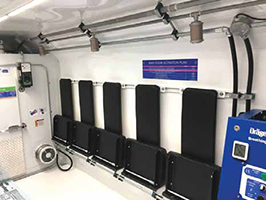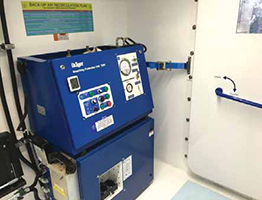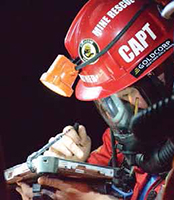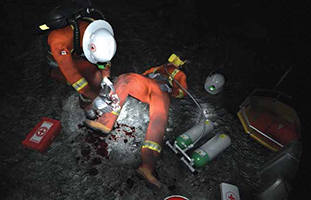
Are we doing enough to train mine rescue responders for future challenges?
(Illustration: NORCAT)
Equipping Tomorrow’s Emergency
Responders
How collaborative development of new technologies is preparing mine rescue teams
for future challenges
By Carly Leonida, European Editor

“Rock bursting is an age-old problem,” said Ted Hanley, vice president of Ontario Mine Rescue. “But, in the late 1980s, early 1990s, the severity of rock bursts in Ontario began increasing as mines became deeper and more expansive. And there was a big emphasis on reinventing mine rescue roles from historical ‘underground firefighters’ to responders able to attend any type of emergency underground.”
While some mines had been relatively “expansive” for some time, they were, until recently, a minority and mainly owned by large operators. There have always been issues surrounding logistics… how to get teams to where they need to be, the physical limitations of humans and equipment, etc. But the widespread adoption of expansive mining — today, it’s the norm rather than the exception — has meant the battle against time, distance and transportation has become infinitely more difficult. “In Ontario, time has to be built in to rally mine rescue teams,” Hanley explained. “We don’t have professional teams of rescuers sitting on the surface waiting to go. At expansive mines, the time can quickly add up to get to the scene of a hazardous situation. During that time, the situation could escalate beyond control, or a worker could be delayed access to critical medical care. “Expansive mining, as a concept, is a threat that’s hanging all around us. And we’re only starting to realize it as these deepening mines begin to have emergencies in their new processes.”
While mines have become much safer over the past 30 years, it also means operators aren’t having as many reminders of the potential for emergencies to occur. A mine might go 10 years or more without experiencing a severe emergency and, in that time, it’s highly possible the depth of the operation could have doubled. It’s vital that mines regularly review and update their emergency response plans to reflect the unique challenges that each operation faces and continually train their teams for every possible eventuality. Given the nature of the challenges that teams face going forward, some of which are yet unknown to us, and the fact that many underground mines will be delving even deeper over the next decade to meet growing metals demands, the only way forward is to collaborate.
Safety Through Equipment
“The main challenge for the mine rescue
process will always be the safety of the
mine rescue responder themselves, and
that responder as a member of the team
unit, and then that process,” Hanley said.
“If we can’t guarantee their safety or put
controls in place to keep them safe, then
that process should not exist.”
The main focus 130 years ago was on getting someone back into the mine following an incident, either to rescue workers who were injured or, in the event of a disaster, to potentially remove people who had lost their life. The development of breathing apparatus was a game changer and, though the concept has evolved significantly over time, it still forms a key part of responder’s toolkits. “The four-hour breathing apparatus we use today was invented in the mid-1990s and it’s about to be replaced by the next generation,” Hanley said. “In the future, we’re probably not going to move toward an eight-hour breathing apparatus, because we are starting to reach the limits of the human being themselves. “You could put an eight-hour apparatus on someone, but they can’t work that hard for eight hours. They’re going to have to leave the mine and rest.
“So, the more we can do to reduce the breathing temperature, resistance, take the weight off the unit… all of those improvements will allow a person to work underground in difficult conditions for longer.” The move to low-cost, high-quality, electronic gas sensors in the late 1990s was also critical to the mine rescue process. Again, gas detectors are a tool that mine rescue responders need to keep themselves safe, first and foremost. They also allow responders to understand the hazards of the situation that they’re involved in and determine whether or not they can do something to resolve it.

Draeger introduced the four-hour breathing apparatus to the Canadian market in 1965, and Armstrong said the company is constantly working to advance the capability of its units. To help overcome the need for responders to consume precious oxygen supplies while traveling to and from the site of emergencies in expansive operations, Armstrong and his team partnered with German mine-vehicle specialist Hermann Paus. The result was the MRV 9000 mine rescue vehicle. “We launched the MRV 9000 at the International Mine Rescue Body (IMRB) meeting in Germany in 2015,” Armstrong said. “It was a development project between Goldcorp and Draeger for two operations in Canada. Since then, we’ve put one into Rio Tinto’s Oyu Tolgoi operation in Mongolia and one at Agnico Eagle’s La Ronde mine in Canada.”
Digitizing Rescue Efforts
Communications and data transfer networks
are also important to enable real-
time collaboration between rescue
teams and those at the surface.
“Wi-fiand LTE technology are not
new,” Hanley explained. “But, for logistical
and cost reasons, through the
early 2000s, wireless technologies just
weren’t being implemented in underground
mines.
“Over the past 10 years, the cost has become negligible in the greater scheme of mining. The technology’s more robust, and so we’re seeing exponential growth in installing that infrastructure and obtaining high data-transfer capabilities underground.” These networks are mainly used for production purposes, personnel and equipment tracking. However, they are also critical to mine rescue efforts and they allow some of the “fancier” technologies that we see today i.e., drones, mapping software and robots, to be harnessed.
Hanley said, “We did a project six years ago, which is just about to be implemented on a province-wide scale, based on digital communications and electronic record-keeping. It aimed to send teams underground with a tablet that talks to management digitally, instead of pencils and paper. “We tested that at the International Mine Rescue Competition in 2016, and the concept was a resounding success.”
The technology was developed with a Canadian company called Focus FS. The software-as-a-service (SaaS) platform digitizes critical operations data for people and assets. It offers different modules such as Health, Safety and Environment (HSE), E-Mustering, Asset Tracking and Emergency Response. The customer can choose from a range of modules and create a solution that best fits their needs.
The Emergency Response module, in particular, allows emergency coordinators and team captains to remain in constant contact via interactive digital maps, notes and photo sharing, with real-time reports and alerts. Oxygen levels, hazardous gas detection, and equipment checks can also be tracked easily and efficiently. In 2019, Draeger partnered with Focus FS to further develop the Mine Rescue Module. “We’re now working to roll that package out to the Canadian market and will expand that to Australia in the future too,” Armstrong explained. “Up until now, everything’s been done with paper and a pencil on a clipboard, which is messy, dirty, and you have to wait until you get to the surface to transmit information to colleagues. This is where the tablet comes into play. The goal is to raise the technology and the safety of the teams, enable better decision making, and enhance proper record keeping post-event.”
Hanley added: “We’re working to implement that platform at all mines in Ontario, regardless of whether they’re wired top-to-bottom. It’ll work in mines that don’t have that communications infrastructure yet, through a synchronization process. But it’s about putting in place a new standard to say that high-quality, live information feedback is the new standard that is expected of the mining industry now, in terms of emergency response.” The beauty of province-wide acceptance is that all operations in Ontario will be using exactly the same software. That means that, if a responder moves to another mine, there will be no change management required. They will be immediately familiar with the system.

Draeger has also been working on its emergency shelters, and recently developed a new portable shelter for Rio Tinto’s Resolution mine in Arizona, which features a new patented cooling system. “We are very proud of that design,” Armstrong said. “The aim is to maintain miners underground in the event of an emergency, because the ambient temperatures at Resolution are in excess of 40°C. We worked together with our engineering solutions team out of Kingston, Ontario, to design that product.”
Draeger has also been awarded a contract to design a new fixed shelter system for Codelco (see accompanying photos). “Knowing that miners are in a safe, controlled environment is vital,” Armstrong said. “That allows management and control on the surface to pause and plan their next actions. It’s so important for mining companies to work together with manufacturers to understand the risks and experiences, limitations, what works and what doesn’t… to ensure that they design and build the best possible solutions. That dialogue is crucial.”
Drones: The New Search
and Rescue
Drones or unmanned aerial vehicles, and
robots are another, very modern, piece
of the puzzle. Now that the cost of these
technologies has come down exponentially,
they are being deployed more regularly
in production and that familiarity and lower
price point have allowed mines to feel
more comfortable in potentially deploying
them for search and rescue missions too.
U.S.-based geoscience, data and engineering firm, RESPEC, has spent the past three years developing a fully autonomous drone specifically to aid underground mine rescue. Ben Haugen, RESPEC’s Remote Geotechnics Program lead, is managing the project in partnership with California-based autonomous systems specialists AutoModality.
“In 2018, we were awarded a research grant by the U.S. National Institute for Occupational Safety & Health (NIOSH),” he said. “Our aim was to develop a fully autonomous drone that can fly in underground spaces and take action of its own accord. In other words, we can give it some instructions and send it into a mine to search the area for downed miners. “It can attempt to do that on its own, without any other instructions, control its own flight, make adaptations if it needs to avoid obstacles, or take a different path to get to its target area. And then, once it gets there and executes on that mission, it can return to base and provide that information to search and rescue personnel.”
The first phase of the project was completed in 2019, and RESPEC and AutoModality received a second round of funding to further develop the system. “The proof of concept involved the drone flying a 5,000-ft roundtrip in a mine, on a single level, and performing a search and rescue task,” Haugen explained. “We’re now expanding that capability.”
The drone uses a pre-loaded, up-todate map of the mine to create the initial flight plan. While it flies, it then collects supplementary data using an onboard LiDAR unit and cameras. It also has range-finding sensors to control the elevation and position within the underground opening. The system compares the sensor data to the map and uses that to locate itself within the mine.
The mission-based system was originally developed to search for and rescue miners. However, when mounted on commercial- scale drones that can carry heavy payloads, it could also be used to deliver respirators or food and water to trapped personnel. It’s hardware agnostic, so could potentially be mounted on an existing drone too.

The project is currently in the third phase, and because travel restrictions have prevented in-mine testing thus far, AutoModality has built a digital testbed using a modelling program that was created for the DARPA Subterranean Challenge — a Homeland Security-focused project, which explored ways to autonomously navigate underground spaces. “They’re basically simulators,” Haugen said. “You create an underground space in a video game-type environment, input all of your sensor data, or your sensor platforms and flight control systems, and all of the details around actually flying an autonomous drone. “That gets fed into the simulation, so it’s about as real as you can get, without actually being in that environment. We’ve been testing in that simulated environment for over a year now and have had a great deal of success. “Our first goal in the latest phase of the project was to expand flights to different levels within a mine, going up an incline or flying in a shaft, for example. Second, was to be able to fly in a space that has never been mapped. For instance, an old working that is not included in that current mine map, or in a situation where the environment has changed, such as a massive ground fall.”
RESPEC and AutoModality hope to be able to commercialize the system by year-end. “We’re looking forward to being able to travel again and finish our testing,” Haugen said. “Our long-term vision for the system is to incorporate it into ‘mines of the future’ that use autonomous excavation and haulage systems. We’ve seen a huge amount of interest from the industry.”
Virtual Experiences For
Better Preparation
The other area where digital technologies
are proving their worth is in preparing
mine rescue teams for different and difficult scenarios underground. Few organizations
have more experience in this field
than NORCAT, another longstanding collaborator
of Ontario Mine Rescue.
CEO Don Duval was on hand to answer questions. “As a global leader in skilled labor training and development for the mining industry, our focus is on both the creation and delivery of leading- edge pedagogically sound training programs that meet the varied needs of our clients,” Duval said. “Our unique blended learning delivery model enables our clients and partners to build and deploy training programs that often encapsulate aspects of online e-learning, classroom-based learning, hands-on experiential training, and more recently, the utilization of learning technologies such as VR, AR and simulation training. This integrated service offering and optionality enables us to work with our clients to build customized and effective training programs.” “About six or seven years ago, NORCAT started to make strategic investments in the development and integration of experiential learning technologies,” Duval said. Today, we have a dedicated studio — Studio NORCAT — that develops and deploys learning technologies into broader training programs such as mine rescue.”
The fundamental benefit of experiential learning technologies is that they provide training and build competence and confidence in scenarios that are often too dangerous and difficult to simulate in real life. “For example, Ontario Mine Rescue runs real-life training simulations in operating mines as part of their broader educational mine rescue programming,” Duval said. “However, what they can’t do necessarily is take it one step further, and for example, set the mine on fire. So, using learning technologies that can create an underground fire scenario is critical to bridging that limitation. The desired outcome is to build both the competence and confidence of mine rescue personnel and do so within the safety of a VR training environment.

The training and utilization of technology can be used for more than just to train an individual on a piece of equipment or in a specific scenario. It can also be used to assess team-based interactions. Mine rescue missions move quickly, and in real life, individuals must make critical decisions in short time frames, so understanding how individuals react and interact in specific scenarios is essential to building the strongest team possible. “Together with Ontario Mine Rescue, we’ve built an avatar-based simulation using a game controller and a 2D screen, where the mine rescue team would have five individuals, and each of them have defined roles,” Duval explained. “You can embed the procedures of what roles and activities need to happen, in what order, before other activities can happen, so the predecessor activities can be defined as in the mine rescue handbook.
“Now you can do entry-level training for a new individual joining a mine rescue team, with other team members sitting at home or in the same room. Team members can communicate with one another using headsets, there’s a time clock, and members can monitor their oxygen levels similar to a real mine rescue environment. “If needed, trainees can pause the simulation, retreat, speak with someone from mine rescue in a classroom environment and, when they’re ready, revert back to the environment and continue. “That experience drives knowledge retention, so when the students do eventually get to a real experience in an underground facility, team leaders know that their responders are confident and competent. The experience in itself — the quality of the graphics, the feel of the controller — call it gamification or not, it’s a meaningful learning outcome that’s really important.”
All of the experiences that are simulated in the 2D avatar-based environment can also be replicated in full VR. This allows trainers to select whichever type of engagement each student reacts best to — some people find that VR headsets can make them dizzy or nauseous, so it’s important to have that optionality. NORCAT uses Oculus VR headsets for its learning experiences. In 2019, the company, along with Ontario Mine Rescue, featured in Facebook and Oculus’ VR for Good campaign to demonstrate how VR can enhance safety in the workplace. “The rate at which the technology, hardware and software to support the quality of graphics in these learning technologies is increasing at an unprecedented rate,” Duval said. “The ability for us now to go underground, capture the specifics of an underground operating mine, as well as the level of quality and the computing power to ensure that it feels real… It’s the best it’s ever been. But, that said, it will continue to improve.”
The NORCAT team has begun work on a new BG4 — PC Pack all-in-one VR backpack. The goal is to provide a completely untethered VR experience so that users can move freely in any given environment. Work has been delayed slightly thanks to COVID, but the team hopes to share more details in the near future. “We continue to work closely with Ontario Mine Rescue, as they make enhancements in their training and development programs, and as they engage new mine rescue workers,” Duval said. “We’re listening to understand what more we can do to enhance our program and make it even more relevant.”
Focusing on Future Challenges
Given that underground mining operations
are only going to get deeper, hotter
and riskier in the future, logistics are only
going to get harder for rescue teams. It’s
also likely that they will encounter challenges
with new technologies that they
probably haven’t dealt with before in rescue
situations… battery-electric vehicles
are a case in point. This is another area
where experiential learning technologies
are proving their worth.
“The battery-electric vehicle challenge is real,” Duval said. “There are mine sites where batteries on these vehicles have caught fire. They are a relatively new investment for a lot of operating mines, be it underground or on surface, around the world. There’s a theoretical training component to educate someone on how to handle that situation; it’s a great opportunity for using VR. “Envision yourself doing a virtual preop circle check on a machine and, all of a sudden, the instructor in the next room says, ‘battery fire, go’. And, you’re doing a circle check, and then the battery catches on fire.
“Do you know where the fire extinguisher is? Do you know where the fire suppression system is? How do you react? If you can gather all that data and then remove yourself from that environment and, after 15 or 20 minutes, sit down with the instructor, go through the specifi- cation of a fire with a battery, understand what you should have done, maybe take a few hours, because the anxiety and the stress level might be quite high… “You can start to appreciate the flexibility and the opportunity of using VR simulation tools to do things like this.”
Hanley said: “The frequency of emergency occurrences underground has gone way down, but the potential severity is going up because of the increased complexity of mines, or the increased use of new technologies. “It’s generally true that a better designed mine, and a mining process that incorporates that recognition of emergency response, from the start or from this point onward, is the most efficient way to improve that process. “There is a distant future where there will be no people working underground in a mine. But, for the foreseeable future, people will be involved in that process, and we need those people to be prepared.”